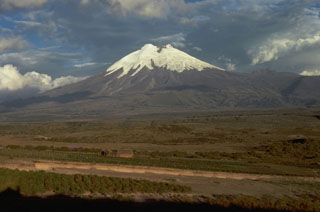Report on Cotopaxi (Ecuador) — December 1975
Natural Science Event Bulletin, vol. 1, no. 3 (December 1975)
Managing Editor: David Squires.
Cotopaxi (Ecuador) Activity declines
Please cite this report as:
Global Volcanism Program, 1975. Report on Cotopaxi (Ecuador) (Squires, D., ed.). Natural Science Event Bulletin, 1:3. Smithsonian Institution. https://doi.org/10.5479/si.GVP.NSEB197512-352050
Cotopaxi
Ecuador
0.677°S, 78.436°W; summit elev. 5911 m
All times are local (unless otherwise noted)
Activity declined during December. The crater steam clouds of previous months were observed only once, on 12 December, since 28 November. Seismic activity was not strong and focal depths were at least 20 km below the volcano. Relevelling of dry tilt stations installed 7 November showed no inflation of the volcano. However, a USGS team including Donal Mullineaux and C. Dan Miller reached Ecuador in late December to assess volcanic hazards and assist the local authorities in contingency planning.
Geological Summary. The symmetrical, glacier-covered, Cotopaxi stratovolcano is Ecuador's most well-known volcano and one of its most active. The steep-sided cone is capped by nested summit craters, the largest of which is about 550 x 800 m in diameter. Deep valleys scoured by lahars radiate from the summit of the andesitic volcano, and large andesitic lava flows extend to its base. The modern edifice has been constructed since a major collapse sometime prior to about 5,000 years ago. Pyroclastic flows (often confused in historical accounts with lava flows) have accompanied many explosive eruptions, and lahars have frequently devastated adjacent valleys. Strong eruptions took place in 1744, 1768, and 1877. Pyroclastic flows descended all sides of the volcano in 1877, and lahars traveled more than 100 km into the Pacific Ocean and western Amazon basin. Smaller eruptions have been frequent since that time.
Information Contacts: M. Hall, Escuela Politécnica, Quito.

